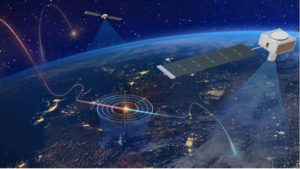A Senate panel would move funding control for the Hypersonic and Ballistic Tracking Space Sensor (HBTSS) back to the Missile Defense Agency from the Space Development Agency (SDA), despite administration reorganization efforts.
The Senate Appropriation Committee’s draft FY 2021 defense funding bill, released last week, would fund the HBTSS effort at MDA with $140 million, including a direct transfer of $20 million in requested HBTSS funds from SDA to MDA.

HBTSS is meant to augment the existing early missile warning satellite constellations to help better detect and track hypersonic weapons from space.
The committee’s explanatory statement report said the committee noted while MDA began the HBTSS program to detect and track hypersonic and ballistic missile threats in fiscal year 2013, in recent times the new SDA has become a new central bureaucratic space to consolidate space funding.
“The Committee understands that the Space Development Agency and MDA will share the responsibility for developing and deploying the HBTSS architecture and constellation under a joint Memorandum of Agreement that defines each agency’s roles and responsibilities, and notes that SDA’s development efforts are fully funded elsewhere within the Research, Development, Test and Evaluation, Defense-Wide appropriation,” the statement said.
While the committee noted that the MDA director submitted a limited acquisition strategy for HBTSS to the defense committees alongside the fiscal year 2021 budget request as directed previously, it did not include “details regarding the overall space architecture to be developed and fielded by SDA and MDA and cost estimate.”
Therefore, beyond moving funds, the panel also would direct the SDA and MDA directors to jointly provide the congressional defense committee the comprehensive acquisition strategy for HBTSS along with the president’s fiscal year 2022 budget request.
The acquisition strategy is directed to include “the components of the architecture, respective fielding plans, contract-type determinations and rationales therefore, plans for technical data management, integrated master test plans and integrated master schedules, as well as the cost estimate by element and for the overall strategy.”
These sentiments on the Senate bill are similar to opposition in the House on shifting HBTSS oversight from MDA to the new SDA.
During a March hearing before the House Armed Services Strategic Forces subcommittee, MDA Director Adm. Jon Hill explained while MDA previously received funds for HBTSS, DoD decided to move funds now to SDA, directed by former Under Secretary of Defense for Research and Engineering Michael Griffin (Defense Daily, March 16).
“I believe it was recommended by Dr. Griffin–he mentioned that recently in public,” he said. “What he was trying to do…he’s trying to consolidate the dollars for space because it’s such an important capability we need,” Hill said at the time.
He noted the overall HBTSS strategy has not changed, only with SDA getting the funding from Congress, which then provides it back to MDA to conduct the actual work.
Rep. Mike Rogers (R-Ala.) responded in the hearing that he thought Griffin should have talked to the committee before making that funding decision.
Then, in June, the House Armed Services Committee’s FY ’21 defense authorization bill draft included a sense of Congress that MDA should be responsible for developing the sensor payload for HBTSS and would limit SDA’s FY ’21 operations and maintenance funds to 50 percent until the Secretary of Defense provided a certification that MDA is responsible for the sensor payload (Defense Daily, June 21).
